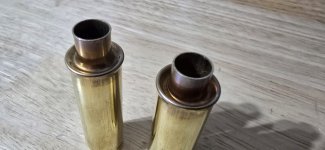I was loading new ADG brass for 7 PRC this AM. I performed no case prep.
First problem, right there.
Done this before, insert primer, charge with powder, seat bullet. While searing the bullet, the neck collapsed at the base (at body of case). This has never happened before. Obviously can’t chamber the round as the OD of the body is enlarged as it squashed out.
What kind of die are you using? The better quality inline micrometer seaters (Redding, Forster, Wilson, etc.) tend to not have that kind of problem. Partly because the body sleeve supports things better, and partly because they don't have any option for crimping depending on how the die is adjusted.
I don’t have a bullet puller.
Go to the local sporting goods store - or Midway/Amazon/whatever, and get one. A generic kinetic 'hammer' style puller works fine. The collet style pullers work better, but cost more and/or are more fussy to set up. Smack it on the floor until the bullet comes out, dump the powder back into the jug, and look at both the bullet OD and the neck ID to see what's going on.
Should I have chamfered the case neck?
On brand new virgin brass? Yes. Run it through a F/L sizing die with an expander, or over a mandrel, whichever you're using, to make sure the new brass is actually *round* and hasn't gotten dinged up in shipping/handling. Then a light chamfer to ease the bullet entry into the case mouth. This is metallic cartridge reloading 101.
Should I have lubricated the inside of the neck?
It probably wouldn't hurt, particularly on virgin brass. Some manufacturers - Lapua for sure, dunno about ADG - finish with a wash cycle that leaves some sort of residue that results in obnoxiously high initial seating force. Like 'holy $hit' seating force - but still not enough to collapse the neck , in my experience. You can either put some sort of lube inside the case necks... or throw the new brass in the tumbler with some used dry media for an hour or so. The tumbler dust does a surprisingly good job of acting like a dry lube on the neck ID, and can dramatically reduce that seating force on virgin brass. FWIW, that tip came straight from a Lapua rep at a big match, years ago.


